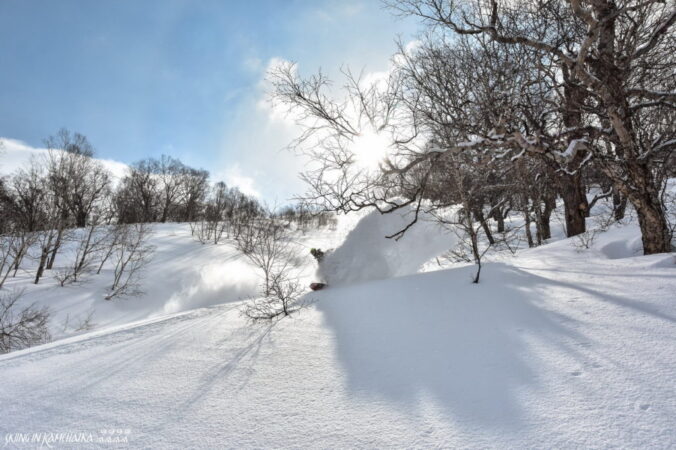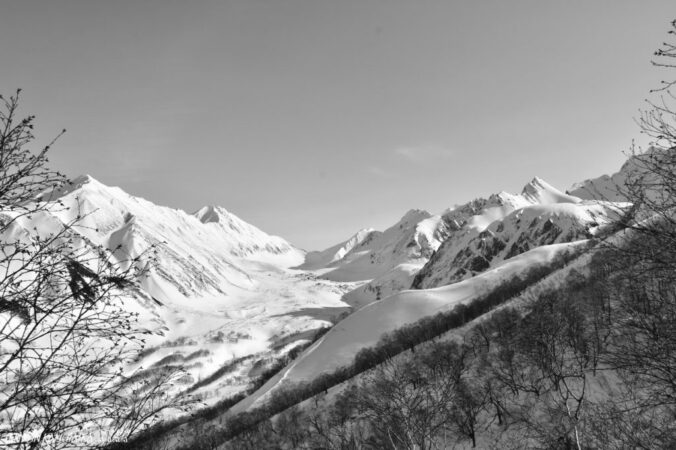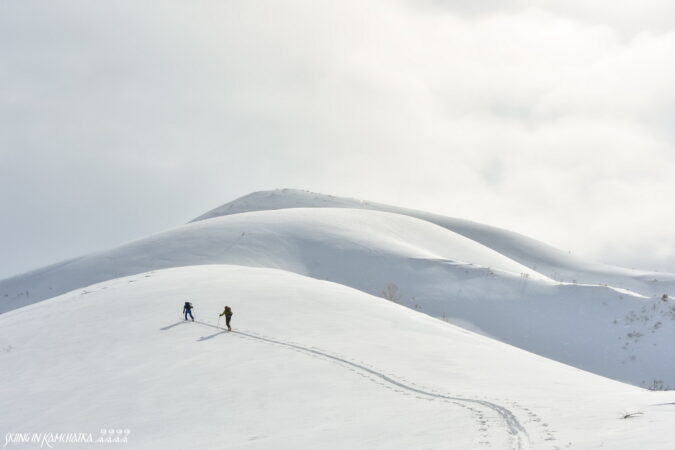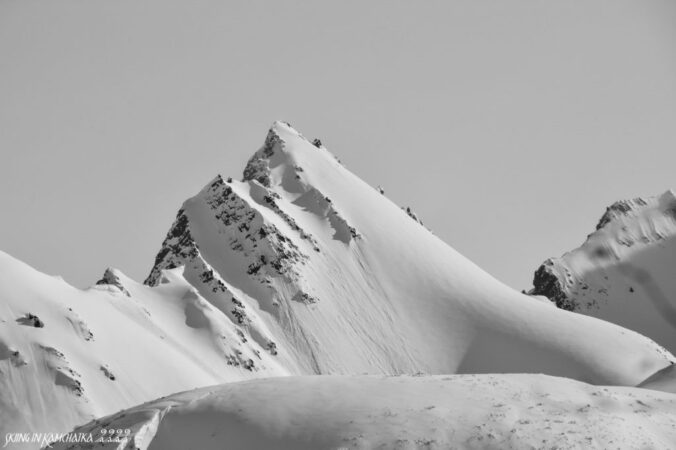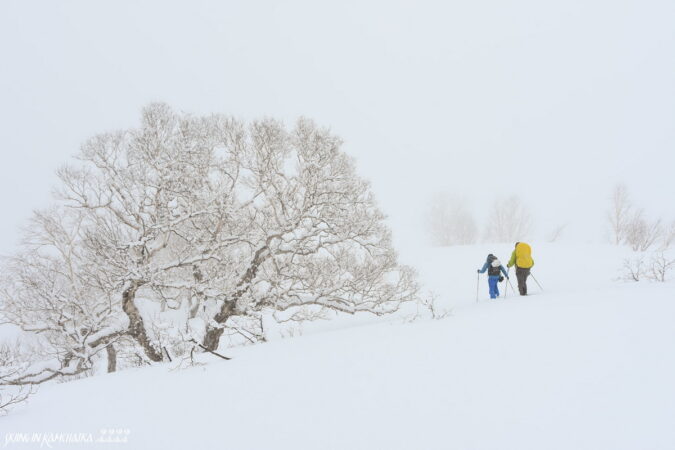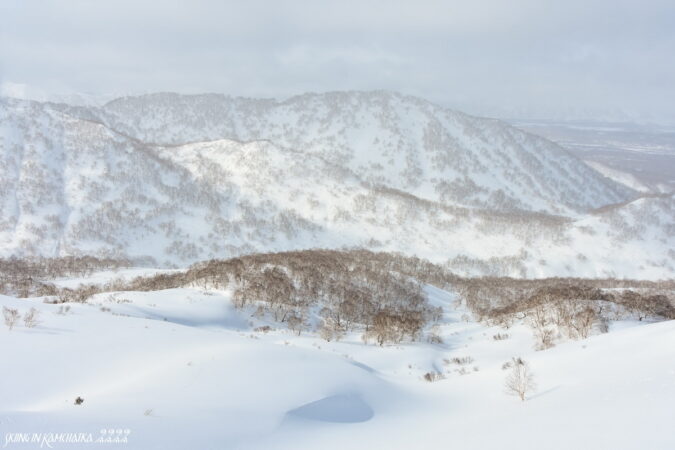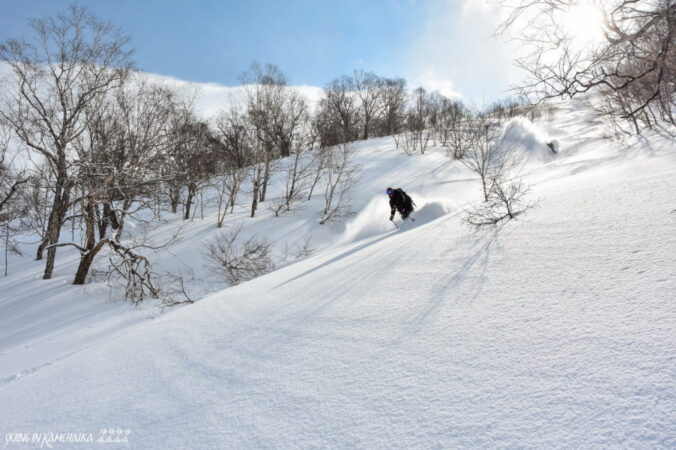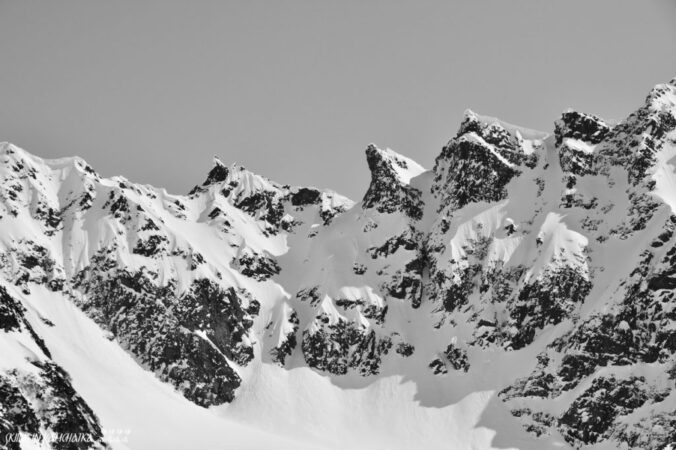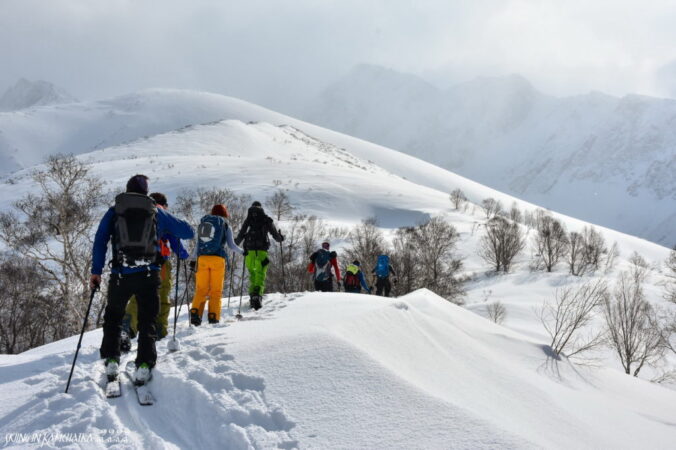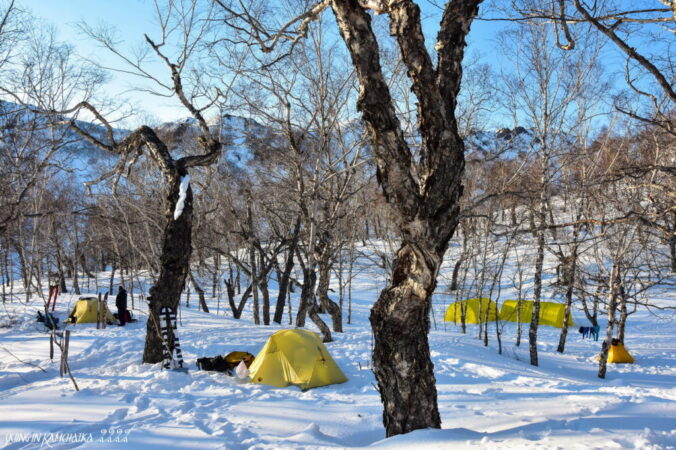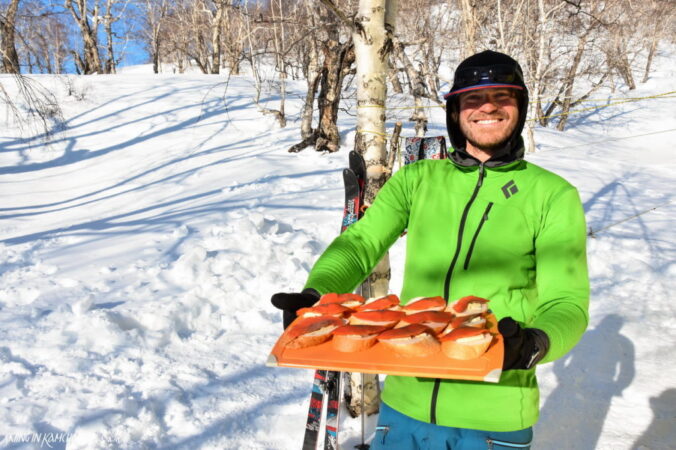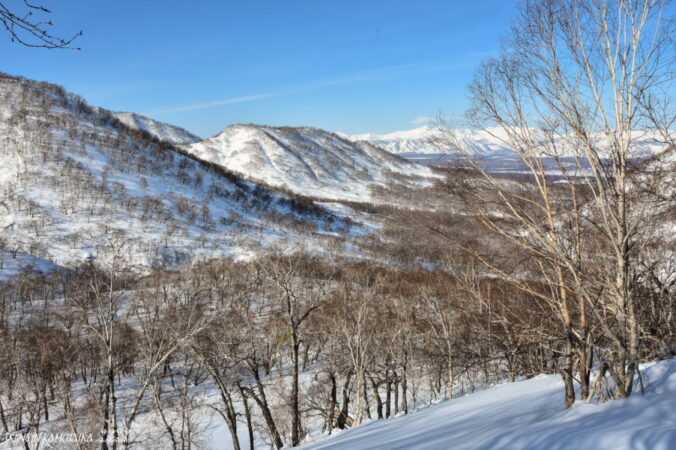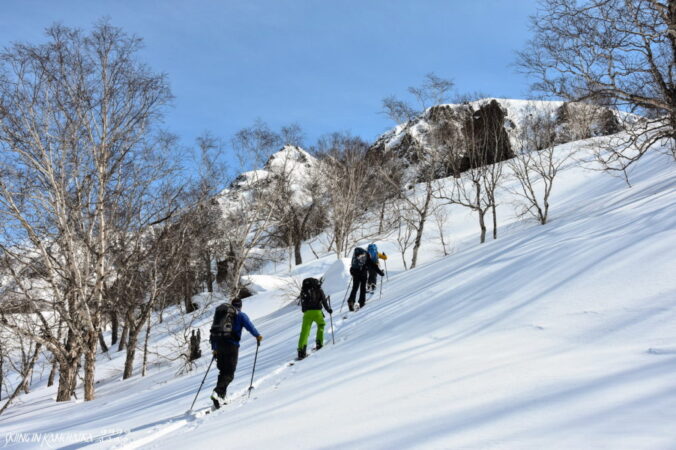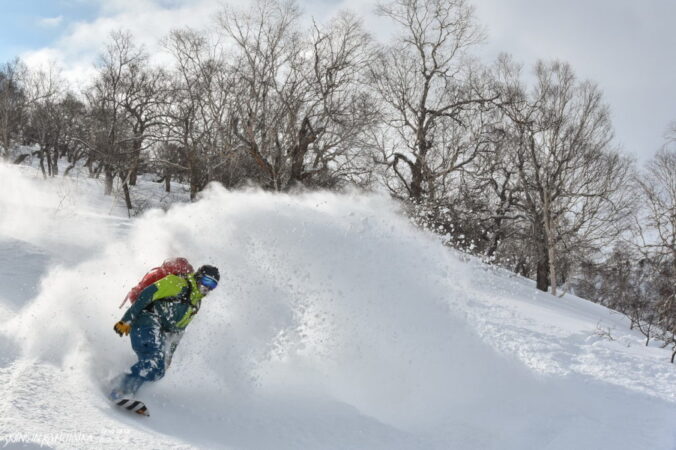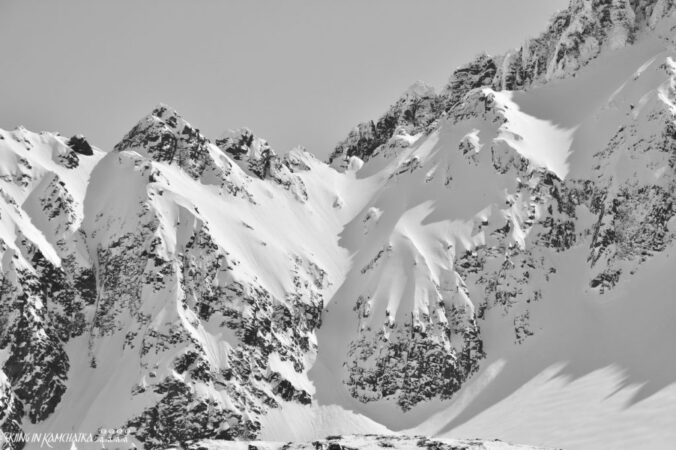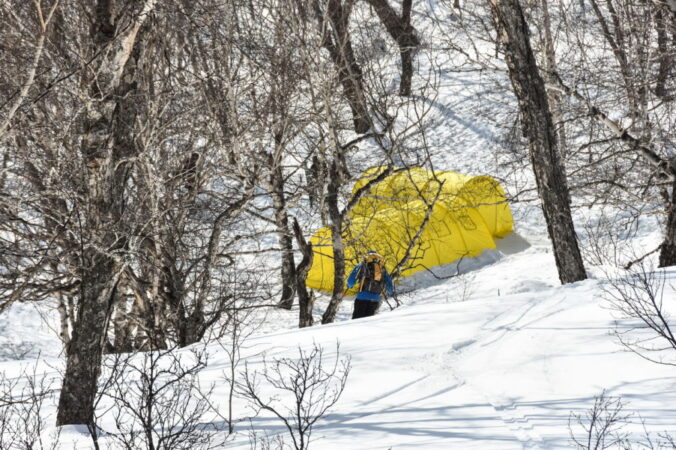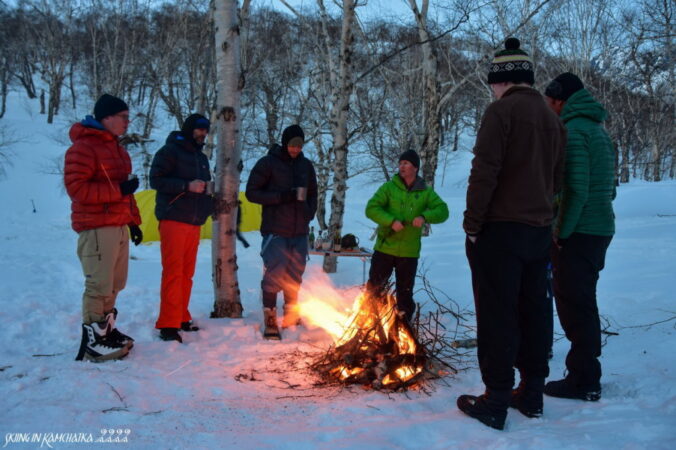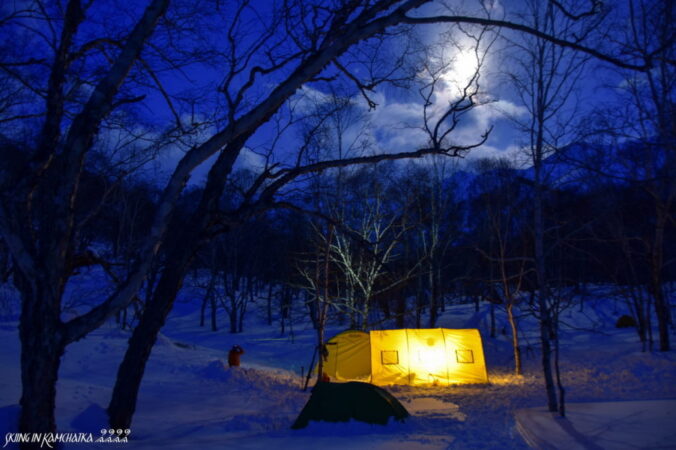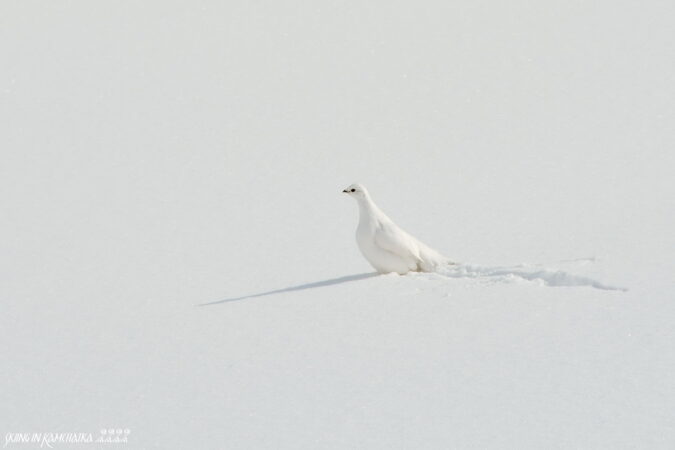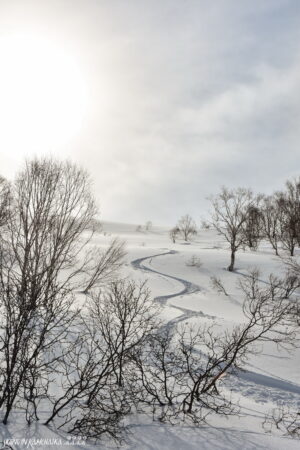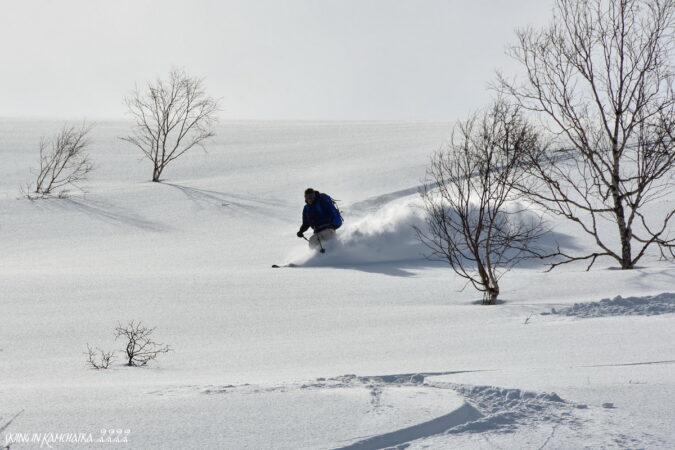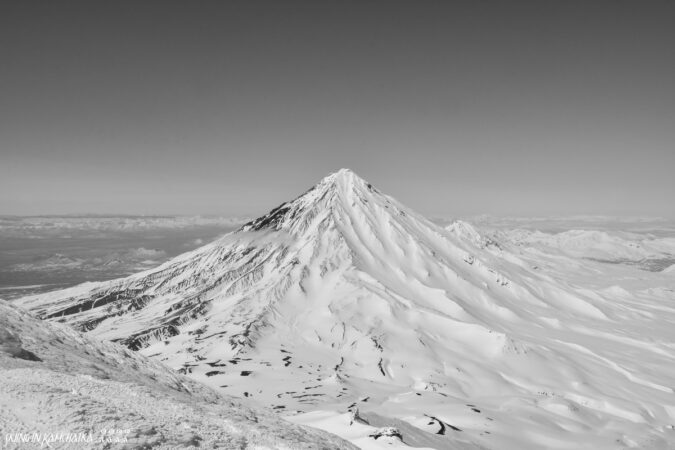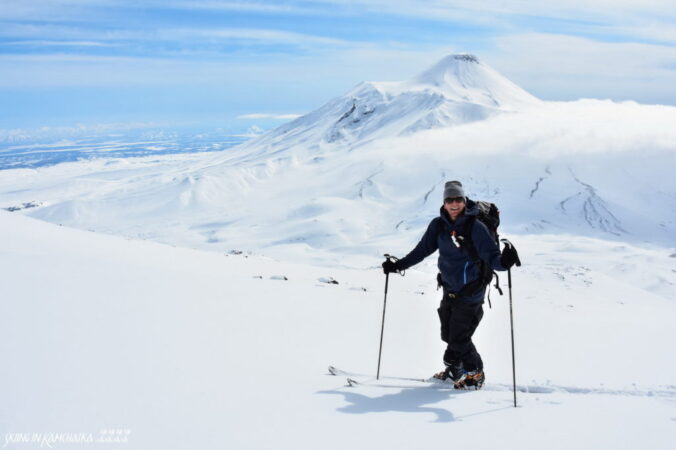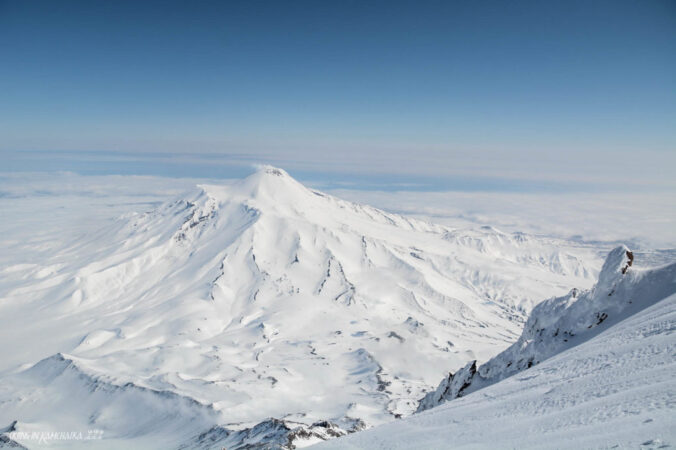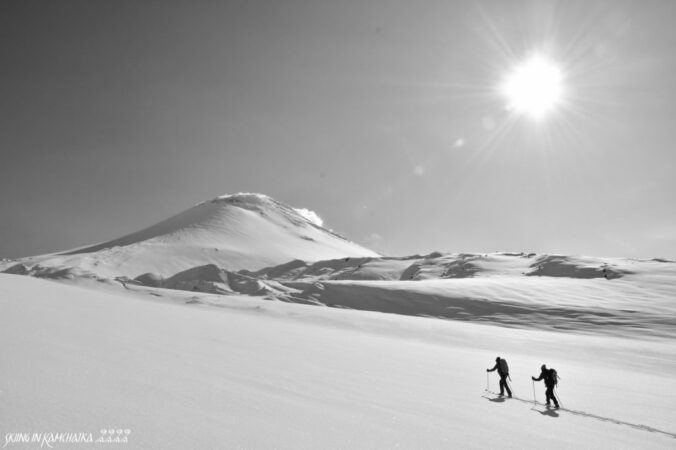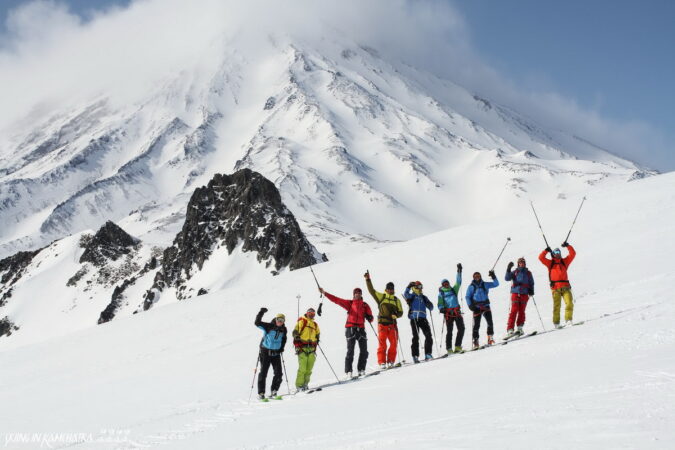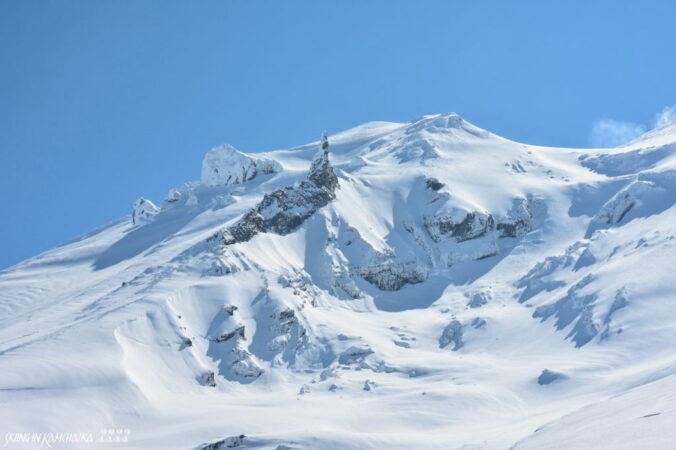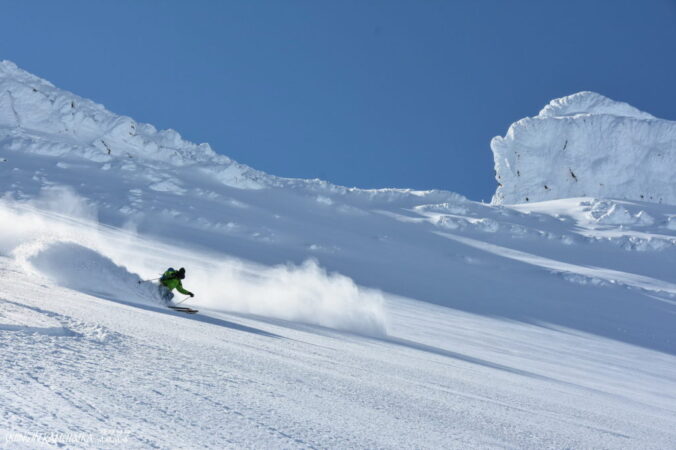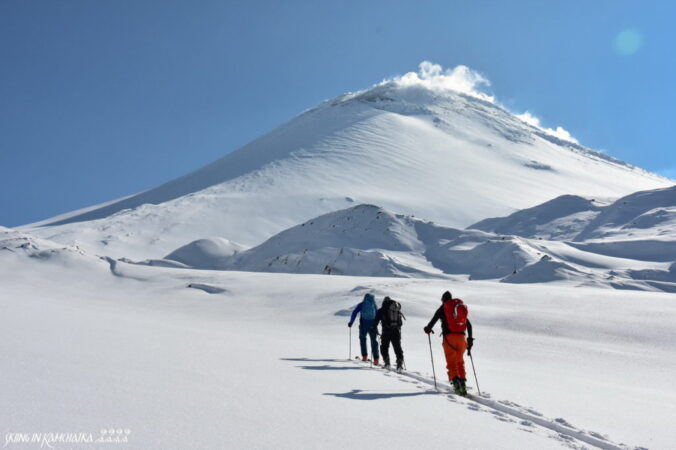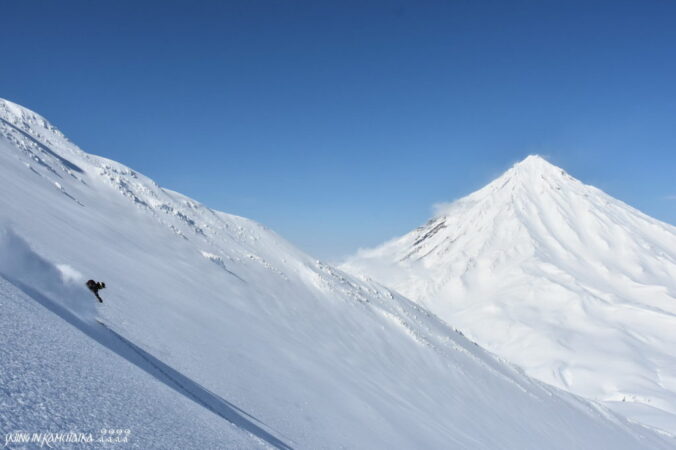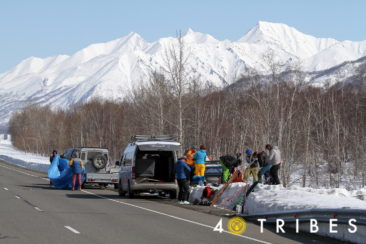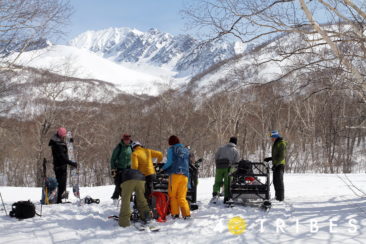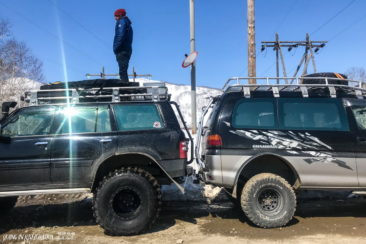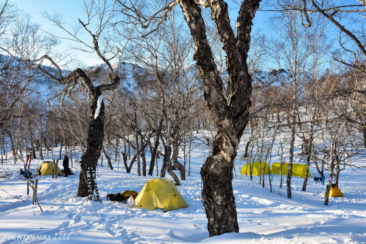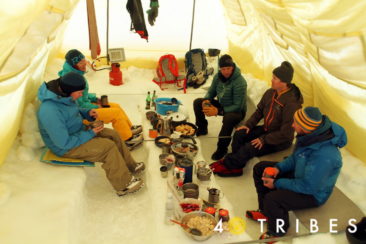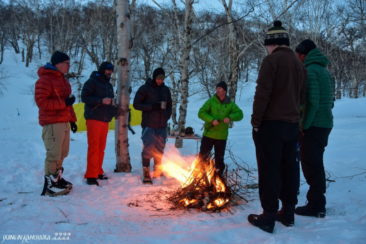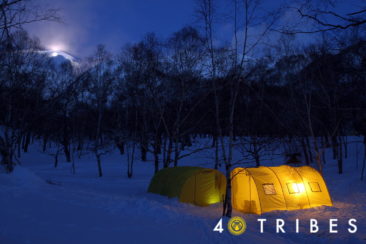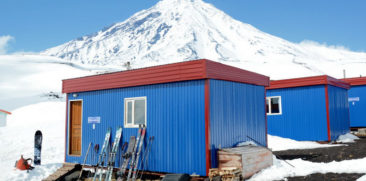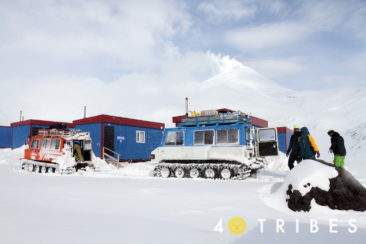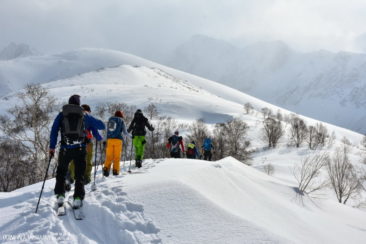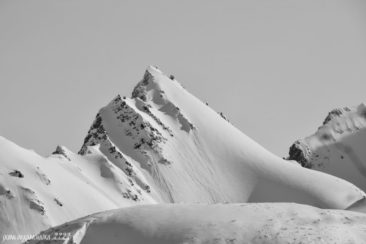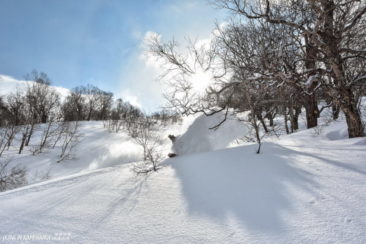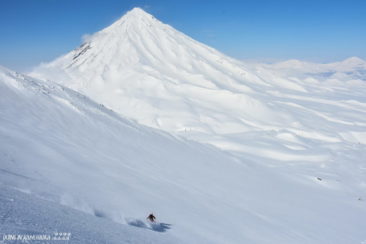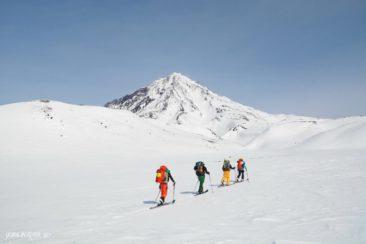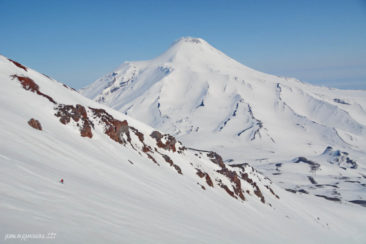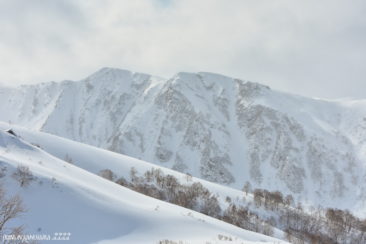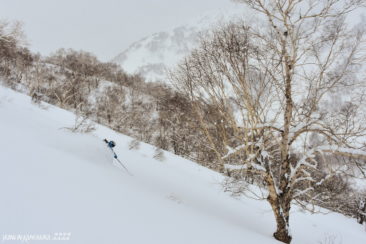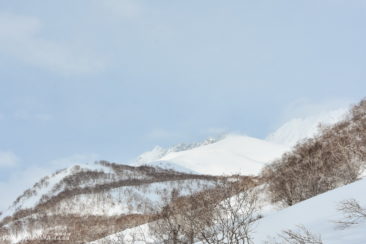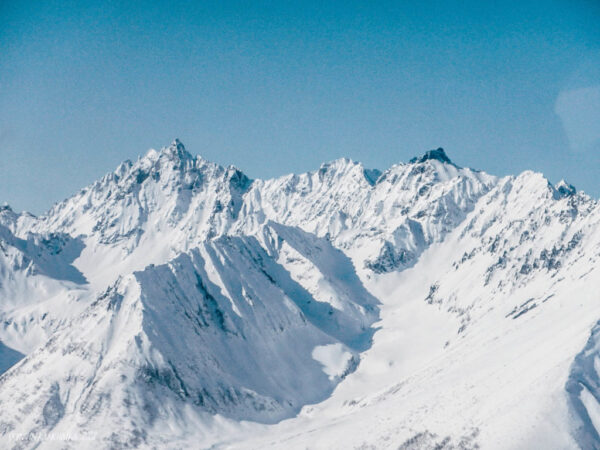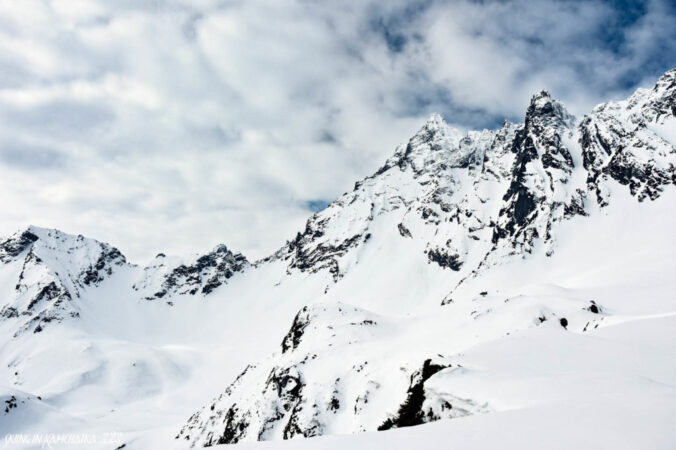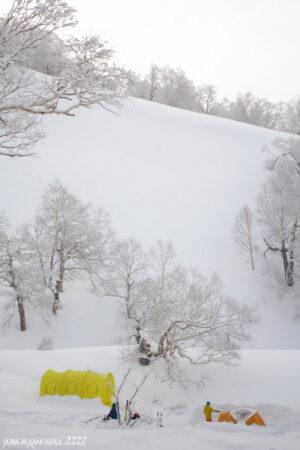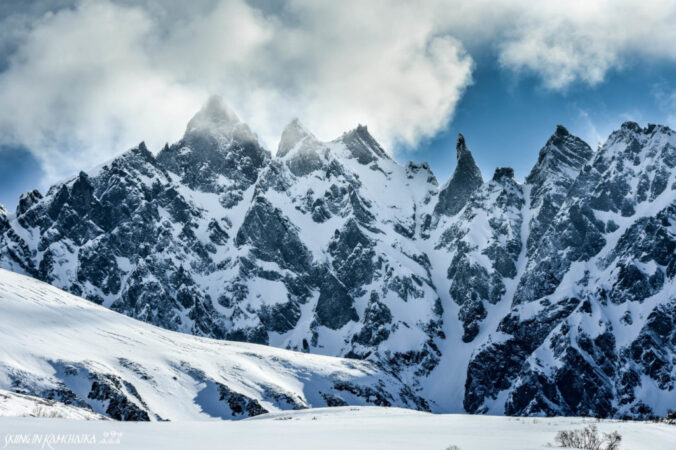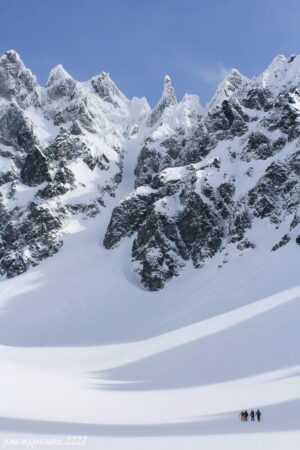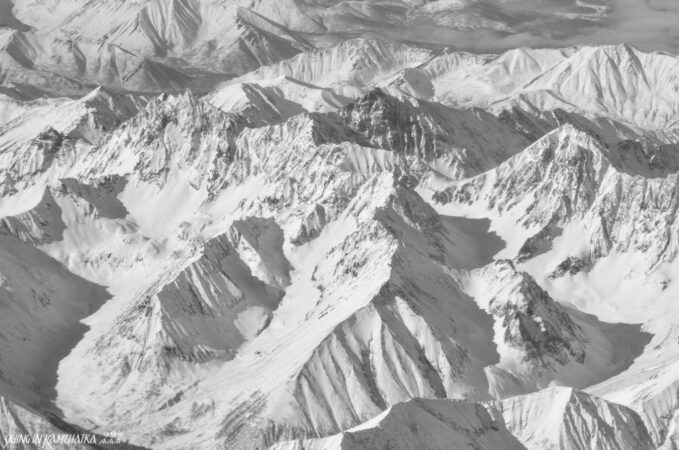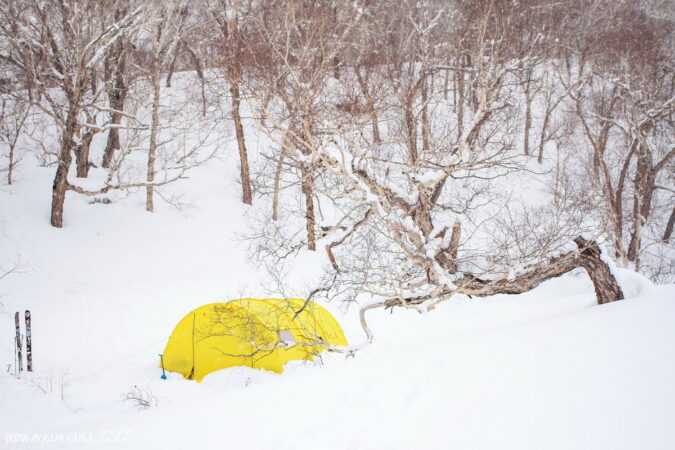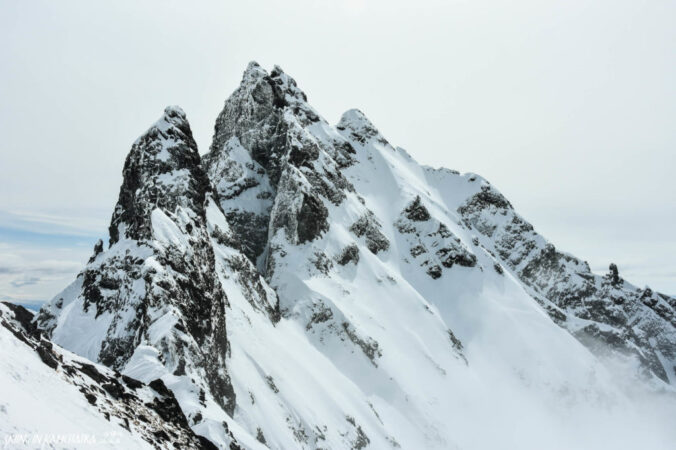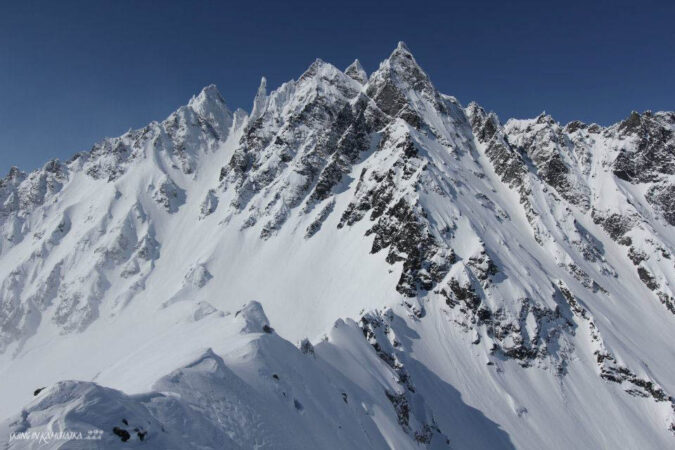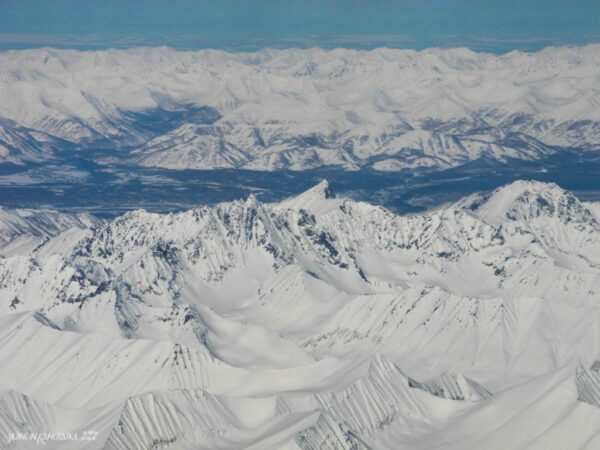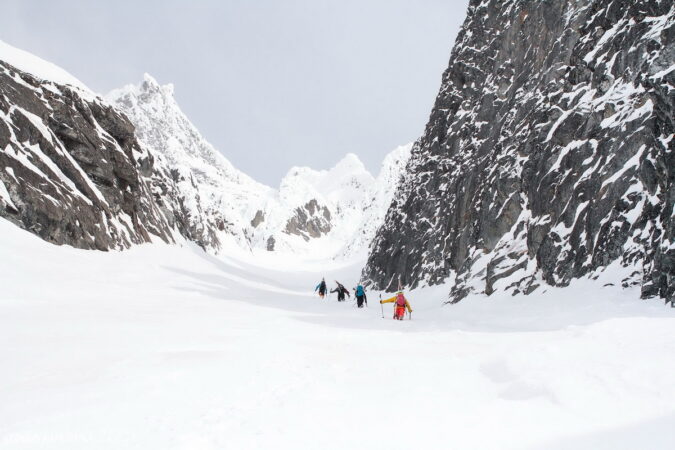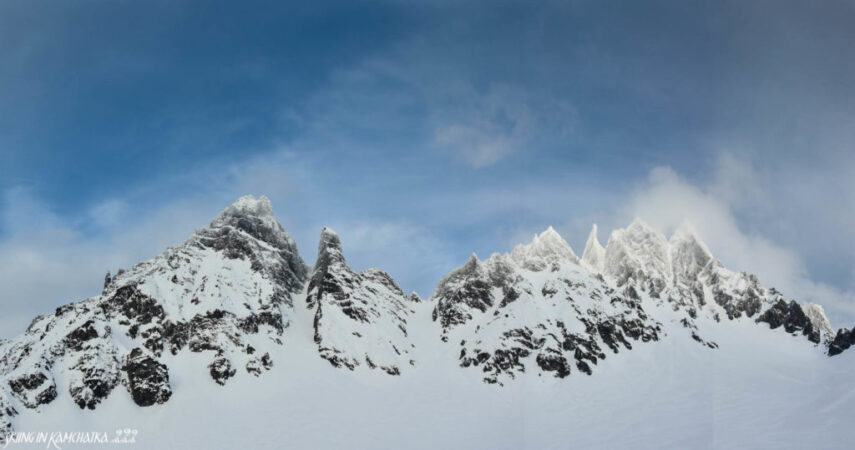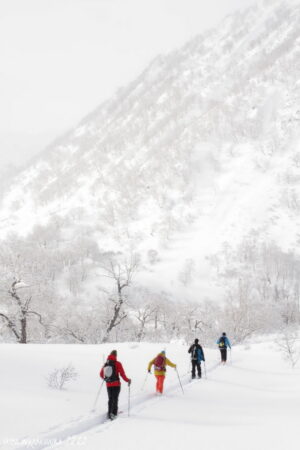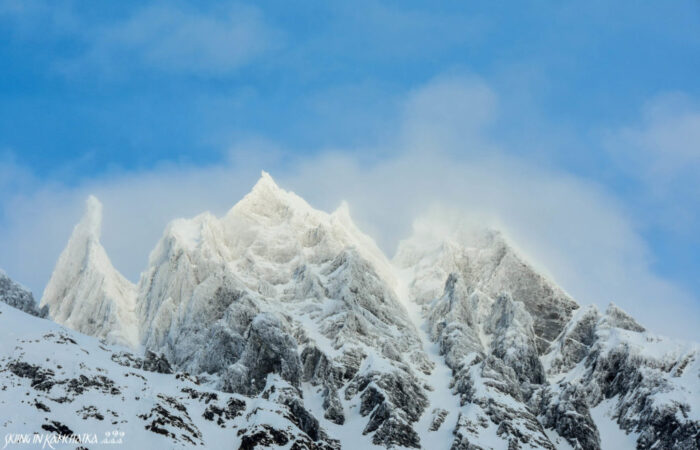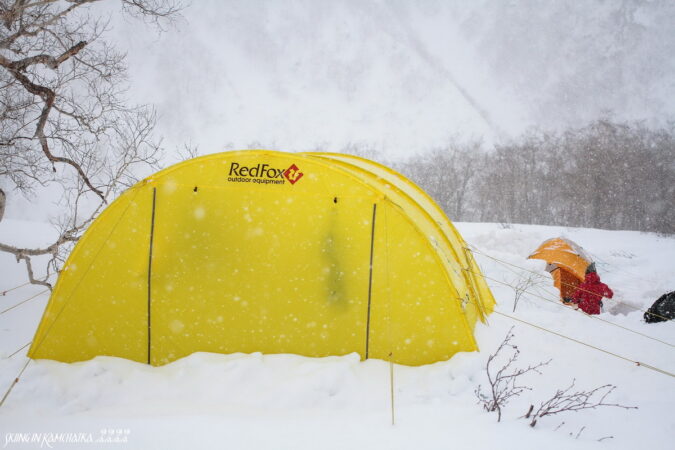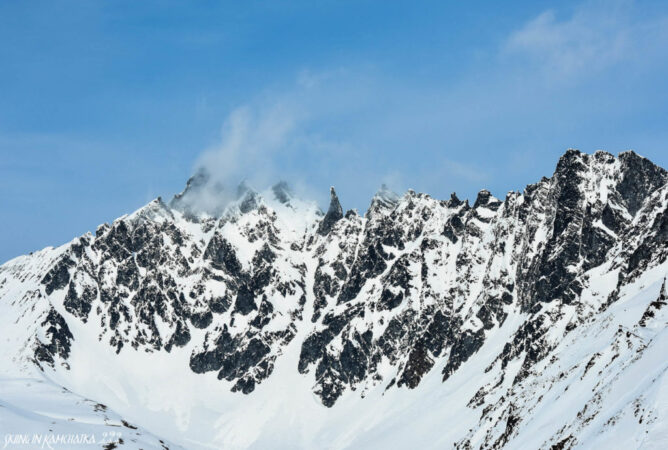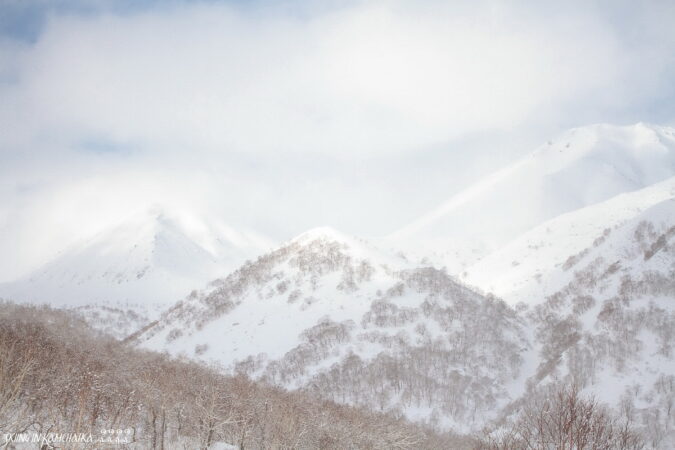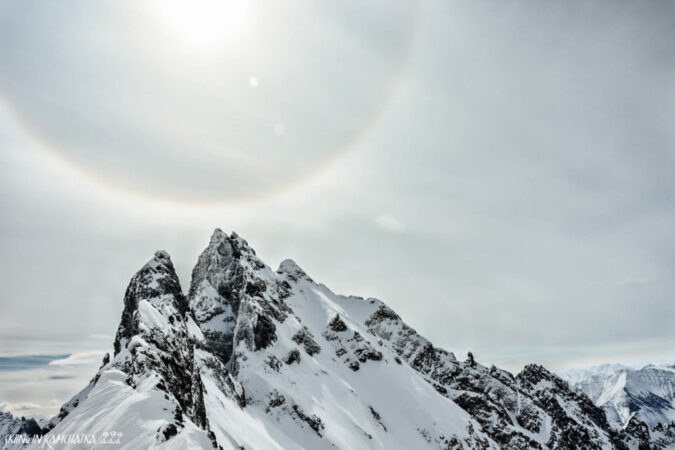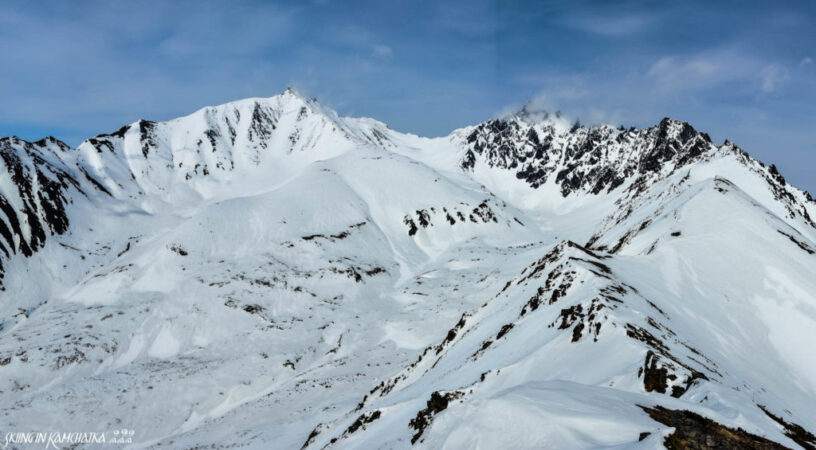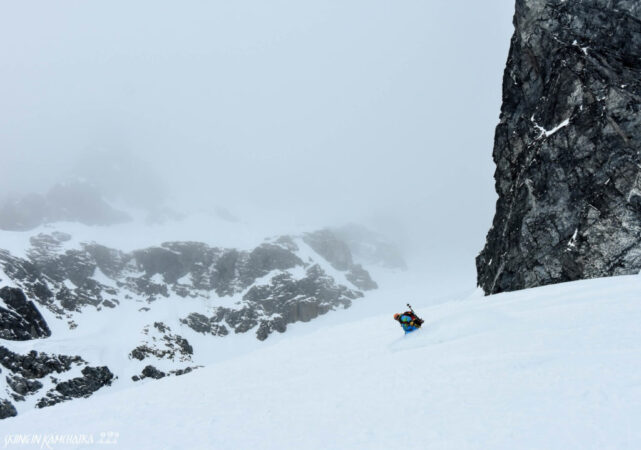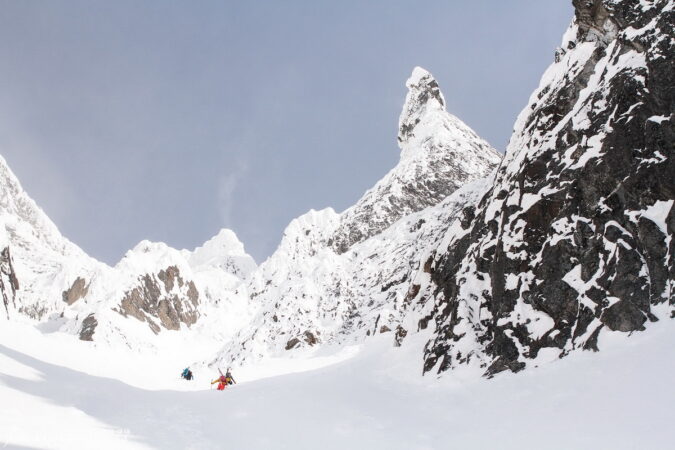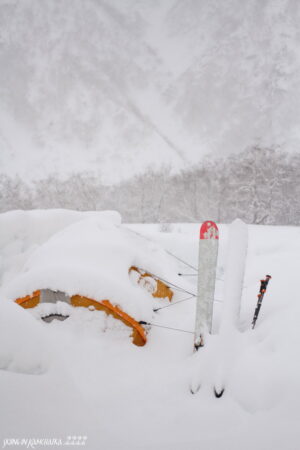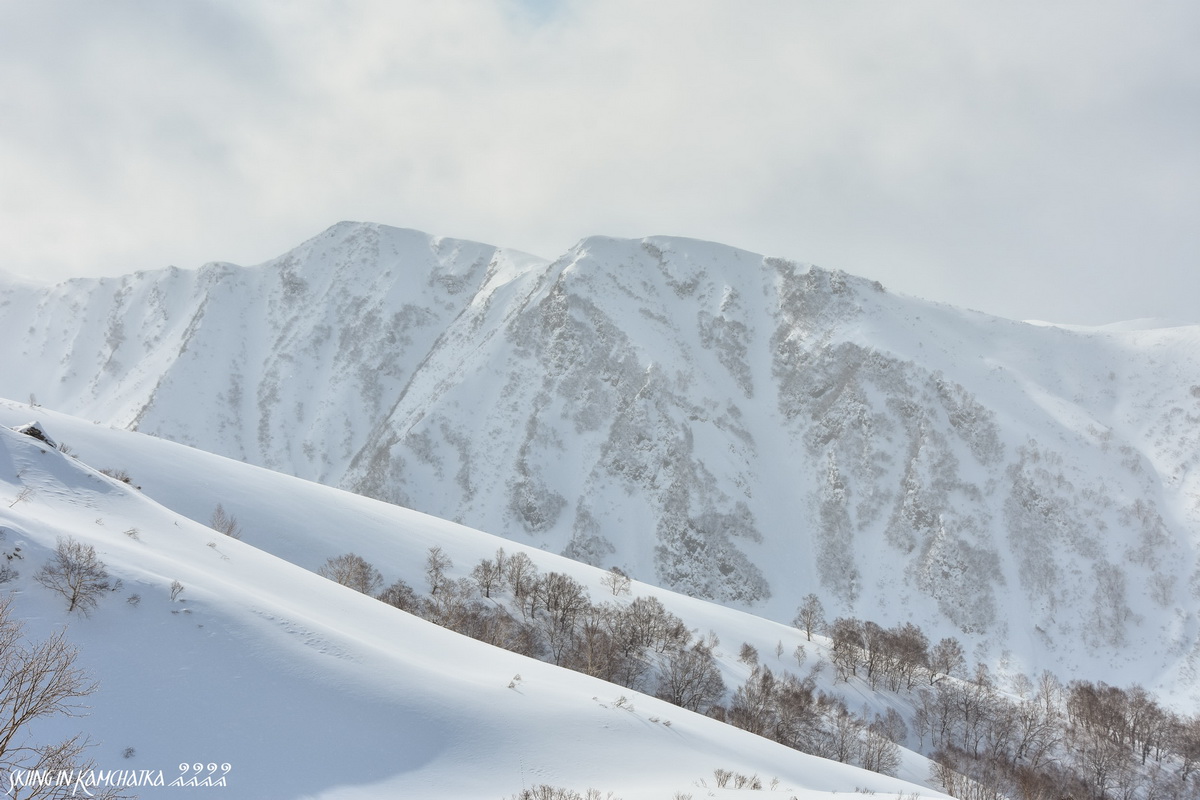

Backcountry skiing camp in Ganalsky range and skitouring on Avachinsky pass
The Ganalsky range is located in 130km from Petropavlovsk, relatively close to the road. It stretches for 80km, with a width of about 20km. The average height of it is 1500-1750m with some peaks reaching 2000m. This range provides super interesting terrain for ski-touring and ski-mountaineering, as well as perfect powder skiing in treeline zone. Steep spicy couloirs and stunning peaks are the hallmark of this area. Many of the ski lines and slopes are still unskied and waiting for you.
There are few mountain valleys where we run backcountry skiing camps. Our main place is in Vaktan Ganalsky valley, and we also run steep skiing camp in Vaktan Malkinsky valley.
Vaktan Ganalsky valley consists of several different sun-valleys, all of them are easily reachable from the camp. Low part of the valleys is a classic Kamchatka’s birch forest (aka #kamkkaido) with the slopes from 25 to 40 degrees, and runs up to 500 vertical meters runs. Alpine zone is an another example of classic Kamchatka terrain – wide open slopes and tiny steep couloirs. We mix all these types of terrain and skiing, to provide best possible skitouring and skiing experience.
On the second part of program we move to Avachinsky pass, stay in mountain hut and skitouring on the slopes of Avachinsky and Koryaksky volcanoes. Skitouring is not very technical, but provides exciting skiing and impressive views. In good weather, you'll see the breathtaking panorama of the Avachinskaya bay, Petropavlovsk, volcanoes surrounding and the Shipunsky mountain range.
BookingDates 2022 (dates of arriving to Petropavlovsk and departure from):
April 03-14
April 10-21
April 17-28
April 24 - May 05
Price: 3540 EUR, per person.
Group discounts available, contact us for details.
Price includes:
- 10 days of skitouring and guiding.
- All transportation according to the programme (vans, snowmobiles, snowcats), except personal transportation during stay in Petropavlovsk and Paratunka village.
- Group airport transfers.
- Accommodation in Petropavlovsk-Kamchatsky, 1st and 11th days. TWIN rooms, with breakfast.
- Accommodation in Paratunka valley, 7th day, TWIN.
- Camping in Ganalsky range.
- Accommodation on the Avachinsky pass (mountain hut).
- Daily Russian Banya (bathhouse) on the Avachinsky pass.
- Meals for all camping days in Ganalsky range and on Avachinsky pass.
- Cooking service.
- Satellite phone use in Ganalsky range
Extra expenses:
- International and domestic airfares.
- Meals in Petropavlovsk and Paratunka.
- Wine and spirits.
- Travel insurance/travel cancellation insurance.
Itinerary
Day 1, Sunday: Arriving in Petropavlovsk; don’t forget to book a window seat - In good weather the view of the mountain ranges and volcanoes of Kamchatka is magnificent; Transfer to the hotel in Petropavlovsk; meet the guides, gear check; rest time.
Day 2: Early morning drive to the Ganaly village (2.5-3 hours); load equipment onto snowmobiles; depending on snow conditions, snowmobiles carries gear and group in turns, or just the gear; if it is not possible to drop off the group, we will have a tour of about 3-4 hours in a birch forest; skitouring on the nearby slopes.
Days 3 to 6: Skitouring/splitboarding in Ganalsky range.
Day 7: In the morning we load our gear on the snowmobile and combine skiing and skinning, slightly downhill, to the road; drive to Paratunka valley, accommodation in the hotel. This day we still can do couple of runs in Ganalsky range, before departure.
Day 8: Early morning transfer to the foot of Avachinsky pass. Accommodation in the huts, skitouring.
Days 9-10: Skitouring on the slopes of Avachinsky and Koryaksky volcanoes.
Day 11: Skitouring, afternoon transfer to Petropavlovsk, accommodation in the hotel.
Day 12: Transfer to the airport, departure
Depending on weather conditions and other factors, we can make changes to the programme.
Program Logistics
There are two daily flights from Moscow (SVO or VKO) to Petropavlovsk-Kamchatsky (PKC), by Aeroflot and Rossiya.
Also, there are few flights fom Vladivostok (VVO) and Khabarovsk (KHV), which can work for flights from Asia or Australia.
Please, check current flight information on the air-company's websites.
Transfer from airport to Petropavlovsk takes 40-50 minutes.
Paratunka valley hotel.
Accommodation in Paratunka valley is 3-stars hotel with twin rooms or private chalet with twin rooms, depending on availability. Both places have pools with hot thermal water.
Avachinsky pass mountain base.
Mountain base on Avachinsky pass is surrounded by big volcanoes and has a nice view on the valley. Huts are simple, but warm (heated by wooden stoves) and clean. Dining room and Banya are separate buildings. The huts has a capacity for maximum 10 people, but in our programs we limit it with maximum 5 persons per hut, to provide the comfort and more space.
Winter tent camping.
Our base camp features a comfortable cooking/dining tent warmed by a gas or wooden heater, along with separate 4-season, 2-person sleeping tents.With a heater you will be able not only warm up if you get cold but also dry the clothes and gear, in cloudy days (when it is sunny, it is easy to dry the stuff on the sun). Toilet is a separate toilet tent.
In our modern world, with widespread mountain huts, not many people camp in the winter. But for places such as Kamchatka, it is essential as there is no other way to explore the mountains. Many of our guests, who have never experienced winter camping before, tell us it is way easier and more comfortable than they expected. With a spacious, heated dining tent, you have space to comfortably sit, chat with new friends and enjoy your meals in a comfortable and warm atmosphere. With your warm sleeping bag and mat, after a substantial dinner, you sleep well in your spacious tent and wake up in the morning to the smell of hot coffee from the dining tent. Life in a winter tent camp is probably easier than you imagine! There are several little tips to make life in a winter camp easier, and our guides will be glad to share their knowledge with you.
In spring 2021 we plan to set up the camp with heated personal tents and folding beds. Details will be announced in summer 2020.
Camp food
We do our best to make the meals, as well as the skiing, a remarkable part of your trip. We include traditional Kamchatka products, such as fish, seafood, reindeer meat and wild plants. Our chefs are all greatly experienced in winter tent camp cooking and will provide meals that are tasty, healthy and nutritious.
There are two hot meals a day. Here are some examples of the menu:
- Breakfast: cold breakfast - cereal/muesli with milk or yoghurt; hot breakfast - fried eggs, bacon/sausages, pancakes. Tea, coffee.
- Mountain lunch: Sandwiches,chocolate bars, dried fruits/ nuts.
- Aprés ski: Smoked salmon or other local fish, fruits.
- Dinner: Local salads; dishes with meat or fish; sides (pasta, rice, potatoes); stewed vegetables. And of course, desserts and herbal teas.
We don’t serve any alcoholic drinks, but you are welcome to bring a reasonable amount of beer, wine or spirits.
We can accommodate special dietary requirements and food allergies. Our guests are asked to complete a registration form, and mention any dietary needs so we can be fully prepared for your arrival. Please note that all food is purchased before the trip starts and we don't have another opportunity to buy anything or change the menu during the trip.
Unlike many other skitour operators, we keep group size relatively small, to provide best possible skitour and skiing experience. Maximum group size is 6 persons. There is one guide per group.
Prerequisites
Because of the nature of the backcountry terrain, we ask our guests to meet a certain level of fitness, skiing and ski-mountaineering abilities. To join our groups, you should be:
- Advanced or higher level of skiing/boarding, in any snow conditions, with at least 3 years ski-tour/ backcountry experience
- Healthy and in very good physical shape.
- Able skin up at least 1200 vertical meters per day.
- Intermediate or higher level of ski-mountaineering (confident user of boot crampons and ice-axe). We might use ski-mountaineering gear for the short sections in the couloirs.
Terrain
Half of the time we ski in the alpine zone and half in treeline. The alpine terrain of the Ganalsky range is varied, and we can ski the wide snowfields or steep couloirs. Treeline skiing - amazing birch tree forest, up to 35 degrees steep, with some terrain features and a views on surrounding peaks. We could call it "Japan-style tree skiing", but it would not be true, cause it is Kamchatka-style tree skiing! Actually, this type of terrain is the same in Kamchatka and Hokkaido, so we simply called it #kamkkaido.
On Avachinsky pass we ski in the Alpine zone. Big, wide fields up to 38-40 degrees steep, classic Alpine couloirs and some nice cruising on a mellow snow fields are all types of terrain you will meet on Kamchatka's volcanoes.
On an average day the vertical drop is 1200-1500m, but it varies according to the group's abilities.
Skiing
This time of year in Kamchatka, we are definitely looking for powder skiing. In the second part of April, we still ski some powder on northern and western aspects, but at the same time there should already be corn snow on eastern and southern aspects. Whatever the snow conditions are, our experience and local knowledge helps us to provide best possible skiing in the area. In past years all our guests were satisfied with the snow quality, check the Testimonials section.
Couloirs skiing
Steep peppery couloirs are one of Ganalsky range's attractions . Besides tree skiing or skiing big fields in alpine terrain, we are definitely looking for couloir skiing. But we have to mention, that it can be not always possible, and here are the reasons why.
Depending on weather and snow conditions, we can climb couloirs without ski-mountaineering gear and technique, just boot-packing all the way to the top. But with hard or even icy snow, climbing requires using the special ski-mountaineering gear and more important – special guide’s techniques. And following international guiding standard for all qualified mountain guides, it is only possible with the group of 1-2 people, and the main reason for it is your safety. In our standard skitouring programmes guide:guests ratio is 1:6 maximum, so obviously we can’t do lot of ski-mountaineering, and we are able to use such a technique only for very short and not very technical sections of couloirs. It does not mean that you have a bad or worse skiing, our guides are always looking for the best possible skiing and boarding in given conditions.
So, please keep in mind, in our standard skitouring/splitboarding programmes we do not guarantee the couloirs skiing (even if we do it quite often), and the final decision will be up to your guide, who base it on weather, snow conditions, group abilities etc.
If you are keen to ski especially couloirs, we can offer you a private programme, focused on the couloirs ascend and skiing. Don’t hesitate to ask us about such a programme or any other questions regarding this topic.
Volcanoes’ ascends
One of the famous things to do in Kamchatka – ski from the top of volcano. But is it always possible? Of course, not always, and there are some reasons for it. First is the weather, and we can’t do any if it not allows us to ascend the summit. But also there is another reason, safety. Here is some explanation about it.
There are two types of skiing/snowboarding activities – skitouring and ski-mountaineering. Its means different types of terrain and different types of techniques, used to achieve the goal. Obviously, ski-mountaineering is more technical and requires not only special gear (such as boot crampons, ice-axe etc.), but also special skills for using it (rope use for belay etc.) For the guided groups another difference is guide:guests ratio. To provide high safety standards and best possible experience, this ratio should be not more than 1 guide:2 guests. And this is international standard for all qualified mountain guides. In our skitouring programs guide:guests ratio is 1:6 maximum, so obviously we can’t do lot of ski-mountaineering, and we are able to use such a technique only for very short and not very technical sections. It does not mean that you have a bad or worse skiing, skitouring on the volcanic slopes is amazing stuff already by itself. Still, in very good snow conditions sometimes it is possible to climb the volcano in group of 6 and do it in a safe manner.
So, please keep in mind, in our standard skitouring/splitboarding programmes we do not guarantee the summit of most of the volcanoes, and the final decision will be up to your guide, who base it on weather, snow conditions, group abilities etc.
If you are keen to climb the volcano and ski from the summit, we can offer you a private programme, focused on the ascend and skiing from the summit. Don’t hesitate to ask us about such a programme or any other questions regarding skitouring and ski-mountaineering.
Weather
Although Kamchatka lies at a similar latitude to Great Britain, cold Arctic winds from Siberia combined with the cold Ohotskoe sea current cover the peninsula in snow from October to late June. Winter months are known for their low temperatures and strong winds, which is why volcano skiing is not enjoyable then. The Spring months bring more comfortable weather - warmer, but still bringing snowfall which transforms into light powder until the end of April, or even the beginning of May up high.
Where we hold our skitouring programme, in April, night temperature is usually about minus 12-15 degrees Celsius, day temperature is around minus 5-6 in the shade, - but it feels significantly warmer in the sun. In general, the weather is identical to conditions in March/April in the Alps. In good weather, the afternoon sun is hot enough to dry gear such as boot liners, gloves etc.
As everywhere, bad weather happens. But generally the weather is stable in April and cyclones don’t last long. In fact last year’s statistics show we were skitouring/splitboarding about 90 percent of the time.
You can check the weather forecast for our skitouring zones here – Ganalsky Range area, Petropavlovsk-Kamchatsky.
Visa and Insurance
To travel to Russia, most foreign nationals are required to have an Entry Visa to Russia. Russian visas can be obtained at your local Russian Embassy or Consulate. In order to apply for a visa you will need proof of your forthcoming visit to Russia, which will be supplied by Skiing In Kamchatka on receipt of your final payment. Provided all the documents are ready, the process usually takes no more than 3-10 working days for a Russian Tourist Visa. It is also possible to ask special agencies for a full visa service.
We will need copy of your visa in 1 month before arrival. This is official government rule, because of border proximity. So, please apply for visa in advance. But even if you decide to come in a last moment, this question can be solved personally.
Insurance
Being adequately insured is a condition of booking a trip with Skiing in Kamchatka. You must have travel and medical insurance, which covers backcountry skiing (skitouring/splitboarding), ski-mountaineering and helicopter rescue. For your peace of mind and to avoid any financial hardship that an unexpected cancellation could cause, we strongly recommend getting Trip Cancellation insurance.
Time in Petropavlovsk-Kamchatsky - GMT+12
Telephone and Internet
There is no cellular coverage in Ganalsky range. For the weather forecasts updates and emergency needs we use satellite phone. You will be able to make a call or send a text message during the trip, if necessary.
On the Avachinsky pass mobile connection is available. We don't have WiFi on Avachinsky pass, but you will be able to use mobile internet on your phone.
Language
Not many people in Russia speak a foreign language (more likely in big towns, less in the countryside). But people are helpful and will easily understand what you need. The alphabet is Cyrillic so reading can be difficult. If you wish to practice your Russian, we recommend you purchase a phrase-book in advance.
During your trip, you will be accompanied by an English-speaking guide. Some of our Ski Guides speak German and French as well, but our general language is English. For private groups, we can try to arrange the guide who speaks your language.
Money
The Russian currency is the Rouble (RUB). No other currencies are accepted for payments. Cards are accepted in most big shops, hotels and restaurants, but this type of payment is still not as wide-spread as in Europe or North America. We strongly recommend that you have enough cash with you for the whole holiday. You can change money in banks (closed on weekends and national holidays) or use an ATM (there are plenty in all towns and cities). You might need some cash during program, take it into consideration.
Moscow transit
There are three international airports in Moscow; Domodedovo (DME), Sheremetyevo (SVO), and Vnukovo (VKO). Depending on your flight plan, you might need to change airports which can be a time consuming. If you do need to change airports, we strongly recommend you allow at least 2 hours for your airport-to-airport transfers.
Please service your skis or board before arrival, or bring pocket waxes as there is no ski-service at our base. We have some repair parts and tools to fix most common problems which might arise, but we do not have equipment for hot waxing.
We advise you to carefully read the following list. You will not be able to buy or rent the equipment out here, so do bring everything with you. If you have any questions about equipment or items on (or not on) this list please don’t hesitate to email and ask for advice.
Here is an example of set of clothes that we recommend. You can change it according to your preferences, but be sure that your clothes suit the weather and temperature during your trip.
Clothing:
- Weather Layer Top - Gore-Tex/Softshell or other waterproof breathable jacket
- Weather Layer Pants - Gore-Tex/Softshell or other waterproof breathable pants
- Warm jacket – Primaloft or similar
- Down/synthetic jacket and overpants warm to minus 15 C., for bivouac.
- Mid-Insulation Layer Top - Polartec 100 or analogue
- Base Layer Top and Bottom, mid or warm – 2 pieces each
- Mid weight socks - 2-3 pairs
- Hat
- Sun cap
- Light gloves
- Insulated gloves or mittens
- Camp winter boots
- Hut shoes
Ski gear:
- Skis or Splitboard
- Skins. Glue should be in good condition, renew if necessary.
- Touring Boots
- Ski crampons
- Telescopic Poles
- Ski helmet
- Binding/Boot/Pole/Skin Repair Kit - tools and parts to fix your personal gear
Ski-mountaineering gear:
- Boot crampons, compatible with your boots. Aluminium or steel, 10/12-points
- Ice axe, 55-65 cm.
- Lightweight harness (Black Diamond Couloir or analogue)
- Carabiner, pear-shaped – 2 pc.
Avalanche gear:
- Transceiver (two antenna minimum), extra batteries.
- Probe
- Shovel
Personal equipment:
- Backpack, 25-35 litres.
- Duffel, for carrying your stuff by snowmobile, water resistant.
- Personal First Aid kit, blister kit.
- Thermos, 0.5-0.7 litres
- Water flask, 1 litre
- Sunglasses, plus extra pair (CE rated 3 or 4)
- Ski goggles
- Headlamp with extra batteries
- Personal toiletries, light synthetic towel.
- Sun/Cold and Lip Cream (SPF30 or higher)
- Earplugs
Camp gear:
- Winter sleeping bag (rated to -20C or warmer). Synthetic is preferable.
- Sleeping pad, 4-seasons (R-value of 3.5 or higher).
We provide spacious 2-person tents, dishes and utensils.
If you prefer to sleep alone, or feel you may disturb your neighbour (snoring, etc.), we strongly recommend you bring a 1-person tent or let us know in advance and we will try to provide personal tent for you.
Dates 2022 (dates of arriving to Petropavlovsk and departure from):
April 03-14
April 10-21
April 17-28
April 24 - May 05
Price: 3540 EUR, per person.
Group discounts available, contact us for details.
Price includes:
- 10 days of skitouring and guiding.
- All transportation according to the programme (vans, snowmobiles, snowcats), except personal transportation during stay in Petropavlovsk and Paratunka village.
- Group airport transfers.
- Accommodation in Petropavlovsk-Kamchatsky, 1st and 11th days. TWIN rooms, with breakfast.
- Accommodation in Paratunka valley, 7th day, TWIN.
- Camping in Ganalsky range.
- Accommodation on the Avachinsky pass (mountain hut).
- Daily Russian Banya (bathhouse) on the Avachinsky pass.
- Meals for all camping days in Ganalsky range and on Avachinsky pass.
- Cooking service.
- Satellite phone use in Ganalsky range
Extra expenses:
- International and domestic airfares.
- Meals in Petropavlovsk and Paratunka.
- Wine and spirits.
- Travel insurance/travel cancellation insurance.
Itinerary
Itinerary
Day 1, Sunday: Arriving in Petropavlovsk; don’t forget to book a window seat - In good weather the view of the mountain ranges and volcanoes of Kamchatka is magnificent; Transfer to the hotel in Petropavlovsk; meet the guides, gear check; rest time.
Day 2: Early morning drive to the Ganaly village (2.5-3 hours); load equipment onto snowmobiles; depending on snow conditions, snowmobiles carries gear and group in turns, or just the gear; if it is not possible to drop off the group, we will have a tour of about 3-4 hours in a birch forest; skitouring on the nearby slopes.
Days 3 to 6: Skitouring/splitboarding in Ganalsky range.
Day 7: In the morning we load our gear on the snowmobile and combine skiing and skinning, slightly downhill, to the road; drive to Paratunka valley, accommodation in the hotel. This day we still can do couple of runs in Ganalsky range, before departure.
Day 8: Early morning transfer to the foot of Avachinsky pass. Accommodation in the huts, skitouring.
Days 9-10: Skitouring on the slopes of Avachinsky and Koryaksky volcanoes.
Day 11: Skitouring, afternoon transfer to Petropavlovsk, accommodation in the hotel.
Day 12: Transfer to the airport, departure
Depending on weather conditions and other factors, we can make changes to the programme.
Program Logistics
There are two daily flights from Moscow (SVO or VKO) to Petropavlovsk-Kamchatsky (PKC), by Aeroflot and Rossiya.
Also, there are few flights fom Vladivostok (VVO) and Khabarovsk (KHV), which can work for flights from Asia or Australia.
Please, check current flight information on the air-company's websites.
Transfer from airport to Petropavlovsk takes 40-50 minutes.
Accommodation
Paratunka valley hotel.
Accommodation in Paratunka valley is 3-stars hotel with twin rooms or private chalet with twin rooms, depending on availability. Both places have pools with hot thermal water.
Avachinsky pass mountain base.
Mountain base on Avachinsky pass is surrounded by big volcanoes and has a nice view on the valley. Huts are simple, but warm (heated by wooden stoves) and clean. Dining room and Banya are separate buildings. The huts has a capacity for maximum 10 people, but in our programs we limit it with maximum 5 persons per hut, to provide the comfort and more space.
Winter tent camping.
Our base camp features a comfortable cooking/dining tent warmed by a gas or wooden heater, along with separate 4-season, 2-person sleeping tents.With a heater you will be able not only warm up if you get cold but also dry the clothes and gear, in cloudy days (when it is sunny, it is easy to dry the stuff on the sun). Toilet is a separate toilet tent.
In our modern world, with widespread mountain huts, not many people camp in the winter. But for places such as Kamchatka, it is essential as there is no other way to explore the mountains. Many of our guests, who have never experienced winter camping before, tell us it is way easier and more comfortable than they expected. With a spacious, heated dining tent, you have space to comfortably sit, chat with new friends and enjoy your meals in a comfortable and warm atmosphere. With your warm sleeping bag and mat, after a substantial dinner, you sleep well in your tent and wake up in the morning to the smell of hot coffee from the dining tent. Life in a winter tent camp is probably easier than you imagine! There are several little tips to make life in a winter camp easier, and our guides will be glad to share their knowledge with you.
In spring 2021 we plan to set up the camp with heated personal tents and folding beds. Details will be announced in summer 2020.
Camp food
We do our best to make the meals, as well as the skiing, a remarkable part of your trip. We include traditional Kamchatka products, such as fish, seafood, reindeer meat and wild plants. Our chefs are all greatly experienced in winter tent camp cooking and will provide meals that are tasty, healthy and nutritious.
There are two hot meals a day. Here are some examples of the menu:
- Breakfast: cold breakfast - cereal/muesli with milk or yoghurt; hot breakfast - fried eggs, bacon/sausages, pancakes. Tea, coffee.
- Mountain lunch: Sandwiches,chocolate bars, dried fruits/ nuts.
- Aprés ski: Smoked salmon or other local fish, fruits.
- Dinner: Local salads; dishes with meat or fish; sides (pasta, rice, potatoes); stewed vegetables. And of course, desserts and herbal teas.
We don’t serve any alcoholic drinks, but you are welcome to bring a reasonable amount of beer, wine or spirits.
We can accommodate special dietary requirements and food allergies. Our guests are asked to complete a registration form, and mention any dietary needs so we can be fully prepared for your arrival. Please note that all food is purchased before the trip starts and we don't have another opportunity to buy anything or change the menu during the trip.
Guiding &Group Size
Unlike many other skitour operators, we keep group size relatively small, to provide best possible skitour and skiing experience. Maximum group size is 6 persons. There is one guide per group.
Prerequisites
Because of the nature of the backcountry terrain, we ask our guests to meet a certain level of fitness, skiing and ski-mountaineering abilities. To join our groups, you should be:
- Advanced or higher level of skiing/boarding, in any snow conditions, with at least 3 years ski-tour/ backcountry experience
- Healthy and in very good physical shape.
- Able skin up at least 1200 vertical meters per day.
- Intermediate or higher level of ski-mountaineering (confident user of boot crampons and ice-axe). We might use ski-mountaineering gear for the short sections in the couloirs.
Terrain
Half of the time we ski in the alpine zone and half in treeline. The alpine terrain of the Ganalsky range is varied, and we can ski the wide snowfields or steep couloirs. Treeline skiing - amazing birch tree forest, up to 35 degrees steep, with some terrain features and a views on surrounding peaks. We could call it "Japan-style tree skiing", but it would not be true, cause it is Kamchatka-style tree skiing! Actually, this type of terrain is the same in Kamchatka and Hokkaido, so we simply called it #kamkkaido.
On Avachinsky pass we ski in the Alpine zone. Big, wide fields up to 38-40 degrees steep, classic Alpine couloirs and some nice cruising on a mellow snow fields are all types of terrain you will meet on Kamchatka's volcanoes.
On an average day the vertical drop is 1200-1500m, but it varies according to the group's abilities.
Skiing
This time of year in Kamchatka, we are definitely looking for powder skiing. In the second part of April, we still ski some powder on northern and western aspects, but at the same time there should already be corn snow on eastern and southern aspects. Whatever the snow conditions are, our experience and local knowledge helps us to provide best possible skiing in the area. In past years all our guests were satisfied with the snow quality, check the Testimonials section.
Couloirs skiing
Steep peppery couloirs are one of Ganalsky range's attractions . Besides tree skiing or skiing big fields in alpine terrain, we are definitely looking for couloir skiing. But we have to mention, that it can be not always possible, and here are the reasons why.
Depending on weather and snow conditions, we can climb couloirs without ski-mountaineering gear and technique, just boot-packing all the way to the top. But with hard or even icy snow, climbing requires using the special ski-mountaineering gear and more important – special guide’s techniques. And following international guiding standard for all qualified mountain guides, it is only possible with the group of 1-2 people, and the main reason for it is your safety. In our standard skitouring programmes guide:guests ratio is 1:6 maximum, so obviously we can’t do lot of ski-mountaineering, and we are able to use such a technique only for very short and not very technical sections of couloirs. It does not mean that you have a bad or worse skiing, our guides are always looking for the best possible skiing and boarding in given conditions.
So, please keep in mind, in our standard skitouring/splitboarding programmes we do not guarantee the couloirs skiing (even if we do it quite often), and the final decision will be up to your guide, who base it on weather, snow conditions, group abilities etc.
If you are keen to ski especially couloirs, does not matter what are their conditions, we can offer you a private programme, focused on the couloirs ascend and skiing. Don’t hesitate to ask us about such a programme or any other questions regarding this topic.
Volcanoes’ ascends
One of the famous things to do in Kamchatka – ski from the top of volcano. But is it always possible? Of course, not always, and there are some reasons for it. First is the weather, and we can’t do any if it not allows us to ascend the summit. But also there is another reason, safety. Here is some explanation about it.
There are two types of skiing/snowboarding activities – skitouring and ski-mountaineering. Its means different types of terrain and different types of techniques, used to achieve the goal. Obviously, ski-mountaineering is more technical and requires not only special gear (such as boot crampons, ice-axe etc.), but also special skills for using it (rope use for belay etc.) For the guided groups another difference is guide:guests ratio. To provide high safety standards and best possible experience, this ratio should be not more than 1 guide:2 guests. And this is international standard for all qualified mountain guides. In our skitouring programs guide:guests ratio is 1:6 maximum, so obviously we can’t do lot of ski-mountaineering, and we are able to use such a technique only for very short and not very technical sections. It does not mean that you have a bad or worse skiing, skitouring on the volcanic slopes is amazing stuff already by itself. Still, in very good snow conditions sometimes it is possible to climb the volcano in group of 6 and do it in a safe manner.
So, please keep in mind, in our standard skitouring/splitboarding programmes we do not guarantee the summit of most of the volcanoes, and the final decision will be up to your guide, who base it on weather, snow conditions, group abilities etc.
If you are keen to climb the volcano and ski from the summit, we can offer you a private programme, focused on the ascend and skiing from the summit. Don’t hesitate to ask us about such a programme or any other questions regarding skitouring and ski-mountaineering.
Weather
Although Kamchatka lies at a similar latitude to Great Britain, cold Arctic winds from Siberia combined with the cold Ohotskoe sea current cover the peninsula in snow from October to late June. Winter months are known for their low temperatures and strong winds, which is why volcano skiing is not enjoyable then. The Spring months bring more comfortable weather - warmer, but still bringing snowfall which transforms into light powder until the end of April, or even the beginning of May up high.
Where we hold our skitouring programme, in April, night temperature is usually about minus 12-15 degrees Celsius, day temperature is around minus 5-6 in the shade, - but it feels significantly warmer in the sun. In general, the weather is identical to conditions in March/April in the Alps. In good weather, the afternoon sun is hot enough to dry gear such as boot liners, gloves etc.
As everywhere, bad weather happens. But generally the weather is stable in April and cyclones don’t last long. In fact last year’s statistics show we were skitouring/splitboarding about 90 percent of the time.
You can check the weather forecast for our skitouring zones here – Ganalsky Range area, Petropavlovsk-Kamchatsky.
Visa and Insurance
To travel to Russia, most foreign nationals are required to have an Entry Visa to Russia. Russian visas can be obtained at your local Russian Embassy or Consulate. In order to apply for a visa you will need proof of your forthcoming visit to Russia, which will be supplied by Skiing In Kamchatka on receipt of your final payment. Provided all the documents are ready, the process usually takes no more than 3-10 working days for a Russian Tourist Visa. It is also possible to ask special agencies for a full visa service.
We will need copy of your visa in 1 month before arrival. This is official government rule, because of border proximity. So, please apply for visa in advance. But even if you decide to come in a last moment, this question can be solved personally.
Insurance
Being adequately insured is a condition of booking a trip with Skiing in Kamchatka. You must have travel and medical insurance, which covers backcountry skiing (skitouring/splitboarding), ski-mountaineering and helicopter rescue. For your peace of mind and to avoid any financial hardship that an unexpected cancellation could cause, we strongly recommend getting Trip Cancellation insurance.
Time in Petropavlovsk-Kamchatsky - GMT+12
Telephone and Internet
There is no cellular coverage in Ganalsky range. For the weather forecasts updates and emergency needs we use satellite phone. You will be able to make a call or send a text message during the trip, if necessary.
On the Avachinsky pass mobile connection is available. We don't have WiFi on Avachinsky pass, but you will be able to use mobile internet on your phone.
Language
Not many people in Russia speak a foreign language (more likely in big towns, less in the countryside). But people are helpful and will easily understand what you need. The alphabet is Cyrillic so reading can be difficult. If you wish to practice your Russian, we recommend you purchase a phrase-book in advance.
During your trip, you will be accompanied by an English-speaking guide. Some of our Ski Guides speak German and French as well, but our general language is English. For private groups, we can try to arrange the guide who speaks your language.
Money
The Russian currency is the Rouble (RUB). No other currencies are accepted for payments. Cards are accepted in most big shops, hotels and restaurants, but this type of payment is still not as wide-spread as in Europe or North America. We strongly recommend that you have enough cash with you for the whole holiday. You can change money in banks (closed on weekends and national holidays) or use an ATM (there are plenty in all towns and cities). You might need some cash during program, take it into consideration.
Moscow transit
There are three international airports in Moscow; Domodedovo (DME), Sheremetyevo (SVO), and Vnukovo (VKO). Depending on your flight plan, you might need to change airports which can be a time consuming. If you do need to change airports, we strongly recommend you allow at least 2 hours for your airport-to-airport transfers.
Please service your skis or board before arrival, or bring pocket waxes as there is no ski-service at our base. We have some repair parts and tools to fix most common problems which might arise, but we do not have equipment for hot waxing.
We advise you to carefully read the following list. You will not be able to buy or rent the equipment out here, so do bring everything with you. If you have any questions about equipment or items on (or not on) this list please don’t hesitate to email and ask for advice.
Here is an example of set of clothes that we recommend. You can change it according to your preferences, but be sure that your clothes suit the weather and temperature during your trip.
Clothing:
- Weather Layer Top - Gore-Tex/Softshell or other waterproof breathable jacket
- Weather Layer Pants - Gore-Tex/Softshell or other waterproof breathable pants
- Warm jacket – Primaloft or similar
- Down/synthetic jacket and overpants warm to minus 15 C., for bivouac.
- Mid-Insulation Layer Top - Polartec 100 or analogue
- Base Layer Top and Bottom, mid or warm – 2 pieces each
- Mid weight socks - 2-3 pairs
- Hat
- Sun cap
- Light gloves
- Insulated gloves or mittens
- Camp winter boots
- Hut shoes
Ski gear:
- Skis or Splitboard
- Skins. Glue should be in good condition, renew if necessary.
- Touring Boots
- Ski crampons
- Telescopic Poles
- Ski helmet
- Binding/Boot/Pole/Skin Repair Kit - tools and parts to fix your personal gear
Ski-mountaineering gear:
- Boot crampons, compatible with your boots. Aluminium or steel, 10/12-points
- Ice axe, 55-65 cm.
- Lightweight harness (Black Diamond Couloir or analogue)
- Carabiner, pear-shaped – 2 pc.
Avalanche gear:
- Transceiver (two antenna minimum), extra batteries.
- Probe
- Shovel
Personal equipment:
- Backpack, 25-35 litres.
- Duffel, for carrying your stuff by snowmobile, water resistant.
- Personal First Aid kit, blister kit.
- Thermos, 0.5-0.7 litres
- Water flask, 1 litre
- Sunglasses, plus extra pair (CE rated 3 or 4)
- Ski goggles
- Headlamp with extra batteries
- Personal toiletries, light synthetic towel.
- Sun/Cold and Lip Cream (SPF30 or higher)
- Earplugs
Camp gear:
- Winter sleeping bag (rated to -20C or warmer). Synthetic is preferable.
- Sleeping pad, 4-seasons (R-value of 3.5 or higher).
We provide spacious 2-person tents, dishes and utensils.
If you prefer to sleep alone, or feel you may disturb your neighbour (snoring, etc.), we strongly recommend you bring a 1-person tent or let us know in advance and we will try to provide personal tent for you.
Vaktan Malkinsky steep skiing camp
In Ganalsky range we also run steep skiing camp in Vaktan Malkinsky valley. Place is famous with Ganalskie Vostryaky massif, one of the most impressive and stunning peaks in the range. The skitouring and skiing there are quite challenging and require very good physical fitness and skiing levels. But the reward will be skiing steep runs, even with some "first descent" lines! Cause of lot of ski-mountaineering involves, guide-guest ratio is only 1:2, which provides safety and best possible ski and ski-mountaineering experience. In days of bad weather (e.g. snowy powder days), when we are not able to stay in the alpine, we will skitour in treeline zone, enjoying classic Kamchatka tree skiing in the birch forest.
We run this programme by request, for private groups from 2 persons.



